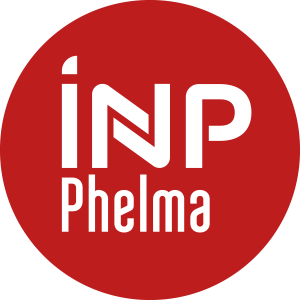Number of hours
- Lectures 9.0
- Projects 0
- Tutorials 9.0
- Internship 0
- Laboratory works 0
ECTS
ECTS 1.5
Goal(s)
Gain better knowledge of the evolution of radio frequency integrated circuits, notably in millimeter waves (30-300 GHz)
Gain extra material on industrial technologies (these 12-hour extra lectures are provided by ST Microelectronics engineers and are shared with SEI-SyRF and master WICS)
Contact Florence PODEVIN, Laurent AUBARDContent(s)
This lecture is given in French on the basis of English written supports
Here is the lecture program
Context
*Applications
*Design exemple
Technology for mmW IC’s
*Back-end
*Active devices
*Passive devices
Passive for mmW
- Lumped vs distributed integrated passives at mm wave
- Integrated transmission lines performance
**Remindings
**Interest for slow-wave effect
**µstrip, CPW, CPS, S-CPW, S-CPS
**Classical versus slow-wave integrated transmission lines - Miniaturization techniques*
--> Training : Capacitive and stub loading
**Phase inverter
**Meandering
**Flexibility in the design - Wilkinson power divider
**Original Wilkinson power divider
**Modified power divider with access to the isolation resistor
*Hybrid coupler
**Original hybrid coupler
**Ports and branch-lines impedances optimisation
**--> Training : reflection type phase-shifter - Rat-race
**Original rat-race
**Compact rat-race with phase-inverter - Distributed phase-shifters
**Principle
**Application
Active for mmW
- Distributed amplifiers
**Historics
**Principle and interest
- --> Training
- Local oscillator
**Design issues
**Layout Issues
- --> Training
- Matching Issues
**Inter stages matching
**50? Output Buffers
- --> Training
Prerequisites
4PMRCRI6 Circuits Radiofréquences Intégrés --> Radio Frequency Integrated Circuits
4PMRPDC5 Passifs distribués et circuits actifs en hyperfréquences --> Microwave distributed passive circuits and active circuits
Calculator authorized
Authorized documents : solely 1 sheet of paper recto-verso, hand-written
En présentiel
SESSION NORMALE :
Types d'évaluation (examen écrit, oral, CC, TP, Rapport, ...) : examen écrit, TP
*Session 1 : 80% note DS écrit de 2h (en présentiel) + 20% note contrôle continu des intervenants industriels (en présentiel)*
*Session 2 : 80% remplacement de la note du DS par un oral (en présentiel) + 20% note contrôle continu des intervenants industriels (en présentiel)*
*Évaluation rattrapable :*
Type d'évaluation : examen écrit session 1
Durée : 2h
Documents autorisés : 1 feuille RV manuscrite
Documents interdits : tout le reste
Matériels spécifiques autorisés :
Calculatrice : oui
Possible en distanciel : non
*Évaluation non rattrapable :*
Type d'évaluation : CC des intervenants industriels
Durée : de l'ordre de 20 minutes en fin d'intervention sous forme de QCM surveillé par l'intervenant
Modalités : avec ou sans les supports suivant les intervenants
[1] “Inductance Calculations” , F. W. Grover, Dover Publications, 2004 .
[2] A. Bautista et al, “Recent advances of CMOS/BiCMOS tunable circuits for mm-wave application” , 45th European Microwave Conference, Worshop 03, Technologies overview for mm-wave tunable circuits, Paris, France, 6 Sept 2015., 2004 .
[3] [MAN-2006] A. M. Mangan, et al, “De-embedding transmission line measurements for accurate modeling of IC designs,” IEEE TED, vol. 53, no. 2, pp. 235-241, Feb. 2006.
[4] [QUE-2010] T. Quemerais , et al, “65-, 45-, and 32-nm Aluminium and Copper Transmission-Line Model at Millimeter-Wave Frequencies,” IEEE T-MTT, vol. 58, no. 9, pp. 2426-2433, Sept. 2010.
[5] [CAT-2007] A. Cathelin , et al, “Design for millimeter-wave applications in silicon technologies,” in Proc. 33rd Eur. SSCC., Munich, Germany, 11-13 Sept. 2007, pp. 464-471.
[6] [AVE-2008] G. Avenier , et al, “0.13 µm SiGe BiCMOS technology for mm-wave applications,” in 2008 Bipolar/BiCMOS Circuits and Technology Meeting, Monteray, CA, USA, 13-15 Oct. 2008, pp. 89–92.
[7] [GIA-2007] F. Gianesello , et al, “1.8 dB insertion loss 200 GHz CPW band pass filter integrated in HR SOI CMOS Technology,” in Proc. IMS., Honolulu, HI, USA, 3-8 Jun 2007, pp. 453-456.
[8] [PEL-2008] S. Pellerano , et al, “A 64 GHz LNA With 15.5 dB Gain and 6.5 dB NF in 90 nm CMOS,” IEEE JSSC, vol. 43, no 7, pp. 1542?1552, July. 2008.
[SIL-2007] A. Siligaris , et al, “CPW and discontinuities modeling for circuit design up to 110 GHz in SOI CMOS technology,” in Proc. 2007 RFIC Symposium, Honolulu, HI, USA, 3-5 Jun 2007, pp. 295 - 298.
[9] [VEC-2009] F. Vecchi , et al, “Design of Low-Loss Transmission Lines in Scaled CMOS by Accurate Electromagnetic Simulations,” IEEE JSSC, vol. 44, no. 9, pp. 2605-2615, Sept. 2009.
[10][LAI-2007] I. C. H. Lai et al, “High-Q Slow-Wave Transmission Line for Chip Area Reduction on Advanced CMOS Processes,” in Proc. IEEE Int. Conf. on Microelectronic Test Structures, Tokyo, Japan, 19-22 March 2007, pp. 192-195.
[11][LEE-2010] J. J. Lee et al, “A Slow-Wave Microstrip Line With a High-Q and a High Dielectric Constant for Millimeter-Wave CMOS Application,” IEEE Microw. Wireless Compon. Lett, vol. 20, no. 7, pp. 381-383, July 2010.
[12] D. Kaddour et al, “High-Q Slow-Wave Coplanar Transmission lines on 0.35-µm CMOS Process,” IEEE Microw. Wireless Compon. Lett, vol.19, no.9, pp.542-544, Sept. 2009.
[13] A.-L. Franc et al, “Compact high-Q, low-loss mmW transmission lines and power splitters in RF CMOS technology,” in Proc. Int. Microwave Symp., Baltimore, MD, United States, June 2011.
[14] J. Wu, “Microstrip Power Divider with Capacitive Stubs Loading for Miniaturisation and Harmonic Suppression,” Microwave Technology Computational Electromagnetics (ICMTCE), 2011 IEEE International Conference on, pp. 237-239, 2011.
[15] M. H. Awida et al, “Compact rat-race hybrid coupler using meander space-filling curves,” Microw. Opt. Technol. Lett., vol. 48, no. 3, pp. 606-609, March 2006.
[16] E. J. Wilkinson, “An N-way Hybrid Power Divider,” IRE Transactions on Microwave Theory and Techniques, vol. 8, no. 1, pp. 116-118, Jan. 1960.
[17] D. Pozar, Microwave engeneering, 4th edition.
[18] S. Horst et al, “Modified Wilkinson Power Dividers for Millimeter-Wave Integrated Circuits,” IEEE Trans. Microw. Theory Tech., vol. 55, no. 11, 2439-2446, Nov 2007.
[19] F. Burdin et al, “Flexible and Miniaturized Power Divider,” International Journal on Microwave and Wireless Technologies, , Online Publication, N° 3, March 2015.
[20] M. K. Mandal et al, “Reduced-Length Rat-Race Couplers,” IEEE Trans. Microw. Theory Techn., Vol. 55, no. 12, pp. 2593-2998, Dec. 2007.
[21] F. Burdin et al, “Millimeter-Wave Rat-Race Balun in a CMOS 65 nm Technology with Slow-Wave Transmission lines and innovative topology,” 32nd Progress In Electromagnetics Research Symposium, PIERS 2012, Moscow, 19-23 August, 2012.
[22] H.-R. Ahn et al, “Arbitrary power division branch-line hybrid terminated by arbitrary impedances,” Electron. Lett., Vol. 35, no. 7, pp. 572-574, April 1999.
[23] T. La Rocca et al, “Millimeter-Wave CMOS Digital Controlled Artificial Dielectric Differential Mode Transmission Lines for Reconfigurable ICs,” in Proc. Int. Microwave Symp., Atlanta, GA, United States, June 2008.
[24] T. La Rocca et al, “60 GHz CMOS Amplifiers Using Transformer-Coupling and Artificial Dielectric Differential Transmission Lines for Compact Design,” IEEE Journal on Solid States Circuits, Vol. 44, no. 5, May 2009.
[25] W. S. Percival, “Thermionic valve circuits,” British Patent 460,562, filed July 24, 1936, granted Jan. 29, 1937.
[26] E. Ginzton, W. Hewlett, J. Jasberg, J. Noe, “Distributed Amplification,” Proceedings of the IRE, Vol. 36, no 8, pp. 956-969, Aug. 1948.
[27] C. Zech et al., “An Ultra-Broadband Low-Noise Traveling-Wave Amplifier Based on 50nm InGaAs mHEMT Technology,” 7th German Microwave Conference, GeMiC, 2012.
[28] D. Fritsche et al., “A trimmable cascaded distributed amplifier with 1,6 THz Gain-Frequency product,” IEEE Transactions on Terahertz Science and Technologie, 14th Oct. 2015.



